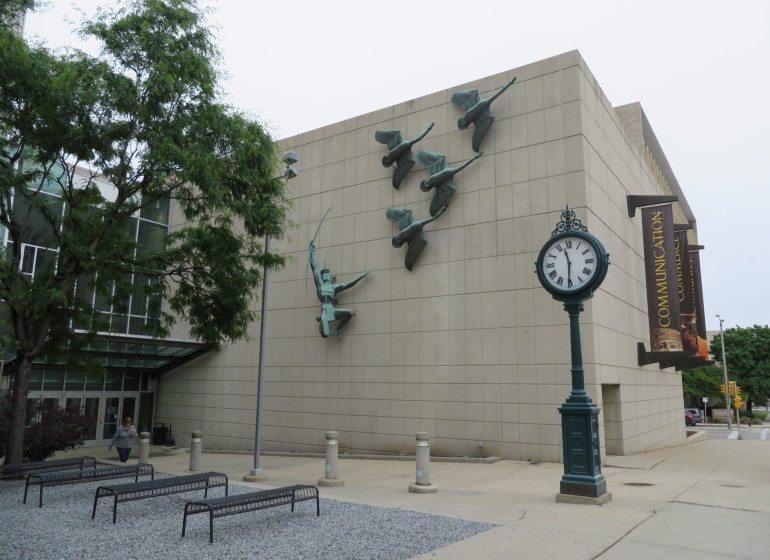The idea has been floated several times over the years: move the Milwaukee Public Museum to the lakefront and create a campus similar to the 2-mile stretch of cultural institutions along Chicago’s South Lake Shore Drive.

It’s an expensive idea. Milwaukee Public Museum President Dennis Kois said it would likely cost more than $100 million to execute. But with a study currently underway that could determine the future of the museum’s home at 800 W. Wells St. in downtown Milwaukee, it’s not outside the realm of possibility a decade down the road.
On Monday, Discovery World CEO Joel Brennan urged Milwaukee leaders to build a lakefront cultural campus around the Milwaukee Art Museum and Discovery World that included the Milwaukee Public Museum and the Betty Brinn Children’s Museum, while presenting his organization’s 2015 financial performance to stakeholders.
While visiting Los Angeles on Tuesday, Kois chuckled at Brennan’s suggestion over the phone.
“I admire Joel’s enthusiasm,” Kois said.
But he cautioned it was too early to tell whether it would be a viable project.
Kois, a Whitefish Bay native and University of Wisconsin-Milwaukee graduate who took over as director of the museum in 2014, said a study will be completed this spring exploring two options for the museum’s future — renovate extensively, or rebuild.
In the meantime, he’s been visiting other museums to gather ideas for future changes at the museum. The Natural History Museum of Los Angeles County, where he visited Tuesday, completed a $135 million renovation project of its then 96-year-old facility in 2009. The museum has multimedia exhibits and modern lab equipment for graduate students and post-doctoral researchers studying its collections.
He also plans to visit the newly-built Natural History Museum of Utah in Salt Lake City and the avant-garde Royal Ontario Museum in Toronto at some point in the future.
“Just like a college or a hospital, museums are accredited,” Kois said. “Our accreditation is up for renewal in 2020, and that process starts in 2018. We know for a fact — I’ve visited other museums for the American Alliance of Museums and accredited them — that there’s no scenario in which the museum will be able to be re-accredited unless we address its infrastructure.”
That’s not to say renovations must be completed or a new building must be under construction in the next two to four years, but it helps in the accreditation process to have a plan in place.
“There’s going to be multiple years of studies, analysis and research,” Kois said. “This is an eight-to-10-year process.”
An out-dated model
The Milwaukee Public Museum has had four homes in its 134-year history, and its most recent, which was designed and built in the early 1960s, has become, by modern standards, an exhibit in and of itself.
“The idea that museums that are shells filled with dioramas and objects, that’s a really old model,” Kois said.
The best modern museums operate by different standards. They don’t just house displays, they conduct scientific research, organize outreach programs, and incorporate new technologies to help apply lessons from the problems of the past to modern-day issues.
“It’s sort of like how 50 years ago people used to go to libraries to research topics and use books,” Kois said. “If you’re going to build a new place for people to research today, you wouldn’t fill it only with books. The same is true with a museum. It’s beloved, and we’re going to keep the best of what people love about it, but it also needs to be a contemporary institution.”
Also driving the study — the museum has infrastructure problems, including maintenance issues and a serious problem in its collection storage facilities.
“The storage facilities absolutely do not meet contemporary museum standards for care of collections,” Kois said. “We’re at some risk for losing our accreditation.”
A study released by the Public Policy Forum in October 2013 estimated the museum needed nearly $28 million worth of capital improvements by 2017 to address deferred maintenance.
The results of the study exploring whether it would be best to renovate or rebuild will be made public by the end of spring and Kois estimated both of the museum’s options will cost more than $100 million.
“This is a long-term discussion,” he said. “Even this spring when we announce, it’s not like we‘re going to be breaking ground next year. There’s going to be multiple years of studies, analysis and research.”
But even if the study were to conclude the museum’s best option is to build a new home rather than renovate its existing location, Kois said the lakefront is just one option the museum would consider.
“I’m not saying yes we would, or no we wouldn’t, but that’s just one location we’d be looking at,” Kois said. “It could mean staying downtown somewhere, or building around the (Bucks) arena or in the Menomonee Valley. Renovate, or build new — that’s the first question. Next question: what’s the budget, and then the question after that is, how do you pay for all of that? Because the cost of either operation would be a nine-figure number.”
In October, the Metropolitan Milwaukee Association of Commerce recommended the county consider imposing a five-year, one-half-cent sales tax to address more than $250 million of deferred maintenance and capital projects at its cultural institutions, including the Mitchell Park Domes, the Milwaukee County Zoo and the Public Museum.
The tax would generate around $325 million over five years, the MMAC projected.


